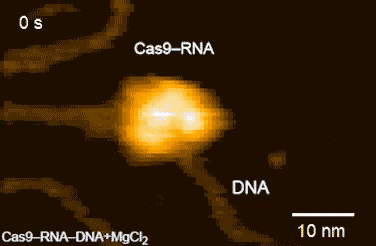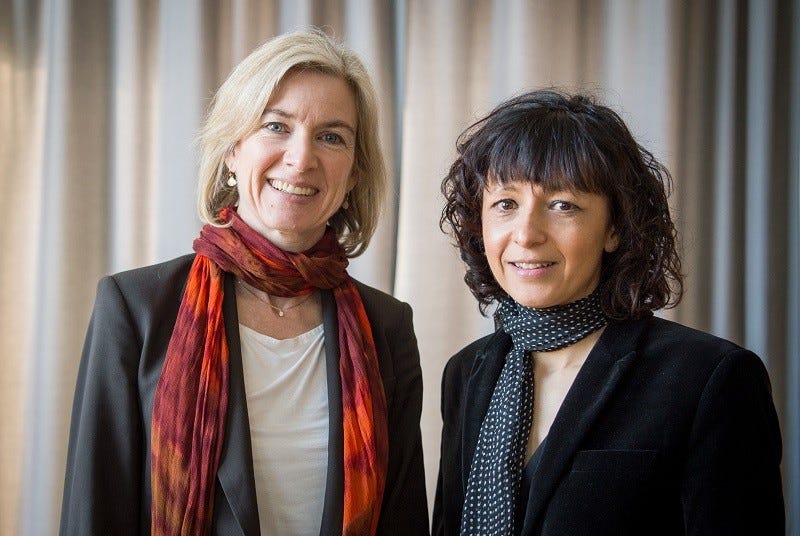Welcome to a new episode of Year 2049, your weekly guide to the events, discoveries, and innovations shaping the future of tech, climate, science, and more.
If this was forwarded to you, subscribe to get a new story in your inbox every Friday 👇
Happy Friday!
Last week on Year 2049’s Instagram page, I was pleasantly surprised to see 80% of you choosing gene editing over space as this week’s topic. I’ll make sure Jeff Bezos, Richard Branson, and Elon Musk don’t find out about my poll results.
CRISPR gene editing has the potential to change humanity as we know it. There’s so much to share and talk about, so I’m going to do it in 2 parts. This week, I’m focusing on CRISPR’s potential applications and impact on healthcare. Next week, I’ll be discussing the challenges and ethical concerns around the technology.
Hope you enjoy this one.
Bad news, good news
Follow Year 2049: Instagram | Twitter | LinkedIn | Webtoon
If this was forwarded to you, subscribe so you can get my comics and stories in your inbox every Friday.
The backstory
The building blocks of life
3.5 billion years ago, life on Earth began.
Single-cell organisms were Earth’s first inhabitants and are the root of all life on this planet. It took 3 billion years for these single cells to start finding other single-celled friends and forming multi-cell clusters. Maybe they were introverted and building up the courage to talk to one another.
Over the past 500 million years, each cluster paved its own path to form all the plants and animals that have ever existed, including ourselves.
Who would’ve imagined what single-cell organisms were capable of? Look at yourself, your pet, or your plants. We don’t pause enough to appreciate the pure magic of nature. It’s truly mind-blowing.
Nature isn’t perfect
For all the evolution and biodiversity that time and nature have brought us, no process is ever flawless.
Take humans for example. The human body is made up of trillions of cells. In their nucleus, cells hold our genetic material, aka our DNA. If DNA is the recipe that makes us who we are, cells are the chef following the instructions.
Like chefs and pretty much anyone else, cells can make mistakes while following our DNA’s instructions which can result in genetic mutations. It’s inevitable like the typo on our resumé, even after we proofread it 17 times. Mutations can also occur because of external factors like being exposed to radiation, chemicals, or viruses.
The consequences of mutations can be severe: over 3,000 genetic diseases are caused by a single incorrect letter in our DNA. This includes cystic fibrosis and sickle cell anemia.
Nice to meet you, CRISPR
In 2005, microbiologist Rodolphe Barrangou, who worked at the food company Danisco, discovered that bacteria had an adaptive immune system called CRISPR.
Think of CRISPR as a log of all the viruses a cell has encountered, which allows it to identify and eliminate them in the future. CRISPR stores copies of viruses in its memory and reuses them to attack them in the future. The most important part of the CRISPR system is the Cas9 protein that can detect, cut, and degrade viral DNA.
Scientists compare the CRISPR-Cas9 system to a pair of “molecular scissors” that can cut DNA with incredible precision.
Look at how the CRISPR system attacks a virus and cuts it out of that DNA strand:
Meet Jennifer Doudna and Emmanuelle Charpentier
Barrangou’s discovery sent the scientific community into a frenzy. Scientists around the world rolled up their sleeves to research CRISPR even further and uncover its mysteries.
Out of these scientists, Jennifer Doudna and Emmanuelle Charpentier made a groundbreaking discovery. In 2013, their teams discovered that the CRISPR-Cas9 system can be programmed to recognize specific DNA sequences which gave scientists the ability to delete or insert specific bits of DNA into cells. All they needed to do is insert a copy of DNA they want to modify into a living cell. It was like a TV remote to control the 3 billion letters of the human DNA.
Doudna and Charpentier became known as the pioneers of the CRISPR-Cas9 gene editing technology and earned the 2020 Nobel Prize in Chemistry. The idea of gene editing wasn’t new, but CRISPR was a significantly easier, faster, cheaper, and more precise method.
CRISPR’s future
CRISPR gene editing could be one of the historic discoveries like fire and electricity that change life as we know it for the rest of our existence. The same way the CRISPR-Cas9 system detects and eliminates viruses in bacteria, it can be used to eliminate specific DNA sequences and replace them. Some possible applications:
1. Reversing genetic mutations
By targeting specific genes, CRISPR can correct genetic mutations in our DNA that cause things like colour blindness, cystic fibrosis, or Huntington’s disease.
In a recent experiment, doctors experimented on 7 volunteers with a rare eye disease called LCA (Leber congenital amaurosis) that progressively deteriorates a person’s vision starting from birth and renders you legally blind at some point. Some highlights of the results:
One patient, Carlene Knight, who couldn’t maneuver her workplace and used a cane, reported significant improvements in her vision that allow her to navigate, spot objects, and see colours.
Another patient, Michael Kalberer, can see colours for the first time in years.
Some patients didn’t experience any improvements because their dose might have been too low or their vision was too damaged, according to the doctors.
The full story of the patients describing their improved vision is so heartwarming. It’s worth a read: A Gene-Editing Experiment Let These Patients With Vision Loss See Color Again (NPR)
2. Treating cancer
CRISPR also has the attention of scientists studying cancer. There have been multiple trials conducted on patients with late-stage cancer, with the first one happening in China in 2016. Another trial at the University of Pennsylvania was conducted in 2019. The goal of these studies was to determine if the treatment was safe and had acceptable side effects, not to cure patients.
In the University of Pennsylvania trial, CRISPR was used to conduct genetic modifications to T cells that can kill cancer:
Adding a synthetic gene that better detects a molecule on cancer cells called NY-ESO-1
Removing 2 genes that interfere with a cell’s ability to detect NY-ESO-1
Removing a gene that interferes with a cell’s cancer-killing abilities
These modifications were conducted in a lab, then injected into patients. For two of the patients that were tested, their tumours stopped growing but resumed growing later. A third patient, with metastatic bone cancer, did not experience any improvements.
However, the treatment was deemed safe and had acceptable side effects which is an important milestone for future and more thorough trials. We’re still in the early days of CRISPR and I’m still very hopeful.
Full story: How CRISPR Is Changing Cancer Research and Treatment (National Cancer Institute)
Final thoughts
Every year, too many people struggle or die from health conditions that are beyond their control. A random mutation or a family condition can be passed down to you and turn your life upside down forever. Everyone deserves a fair and equal chance at life without any disease or illness, and CRISPR has the potential to make that a reality.
CRISPR gene editing is one of the things I’m most excited about when it comes to the future. I hope we get to a day where, when given an unpleasant diagnosis from a doctor, we’re instantly relieved to know that there’s a quick and affordable treatment that can save our life. Even if CRISPR doesn’t cure all our diseases or illnesses, it could become a more affordable and less gruesome treatment for the already-struggling body compared to something like chemotherapy. That on its own would be a big win.
However, affordability should not equate to ease of access. Gene editing must be used with caution because it can change humanity as we know it, especially if modifications can be inherited by future generations. If it’s for curing a disease, you should have the right to access it. If it’s for making your child taller and stronger so they can make it into the NBA, then no.
The concerns and challenges of CRISPR deserve their own edition because there are a lot. In true Year 2049 fashion, I like to examine the good and the bad behind our discoveries and inventions so I’m dedicating next week’s edition to that.
For now, appreciate how much good can come from CRISPR and that we’re alive to see its progress.
A question for you
Do the benefits of CRISPR outweigh the potential misuses of the technology?
Leave a comment and let me know 👇
Deep dive
Some additional links to satisfy your curiosity:
How CRISPR lets us edit our DNA - Jennifer Doudna (TED/YouTube)
Genome Editing with CRISPR-Cas9 (McGovern Institute/YouTube)
Genetic Engineering Will Change Everything Forever – CRISPR (Kurzgesagt/YouTube)
CRISPR Clinical Trials: A 2021 Update (Innovative Genomics Institute)
If you missed the previous episode
Help me spread the word ❤️
Doing the research, learning about new topics, making comics, and writing this newsletter has been an absolute joy for me every week.
Each edition takes about 8-10 hours to make, so I would appreciate it if you took a minute to share Year 2049 with your family, friends, or colleagues who would enjoy reading this and invite them to join us on our weekly trips to the future!
or share this link: https://year2049.substack.com/welcome
Much love,
Fawzi
How would you rate this week's edition?
















I stumbled upon this page on the Futurology subreddit. I love the simple language you use, yet managing to communicate salient information. For someone who knew nothing about CRISPR, this is a fantastic intro. Many thanks.
There is always an ethical component when you start messing with genes and DNA. Unfortunately, humans are not always ethical.